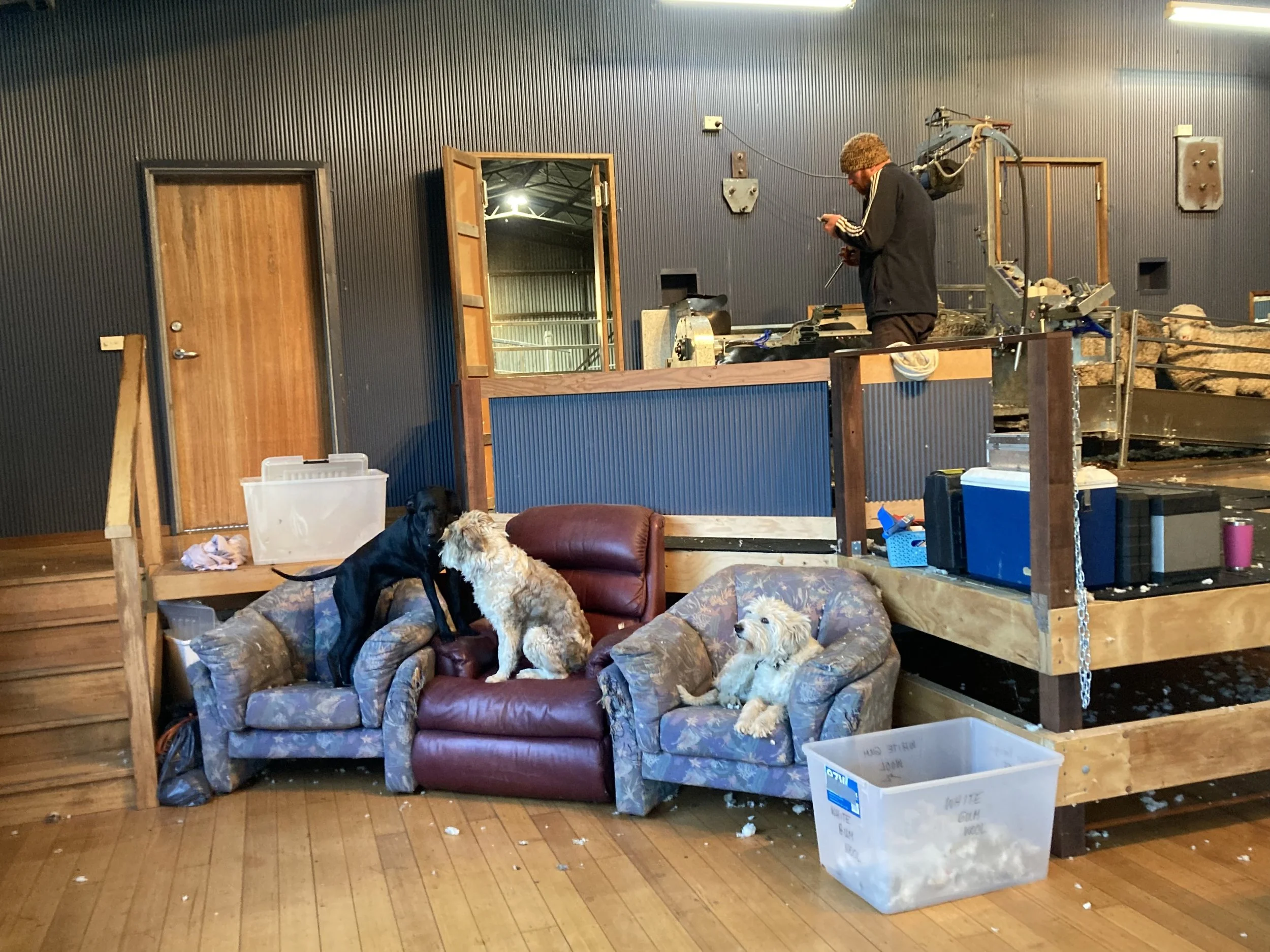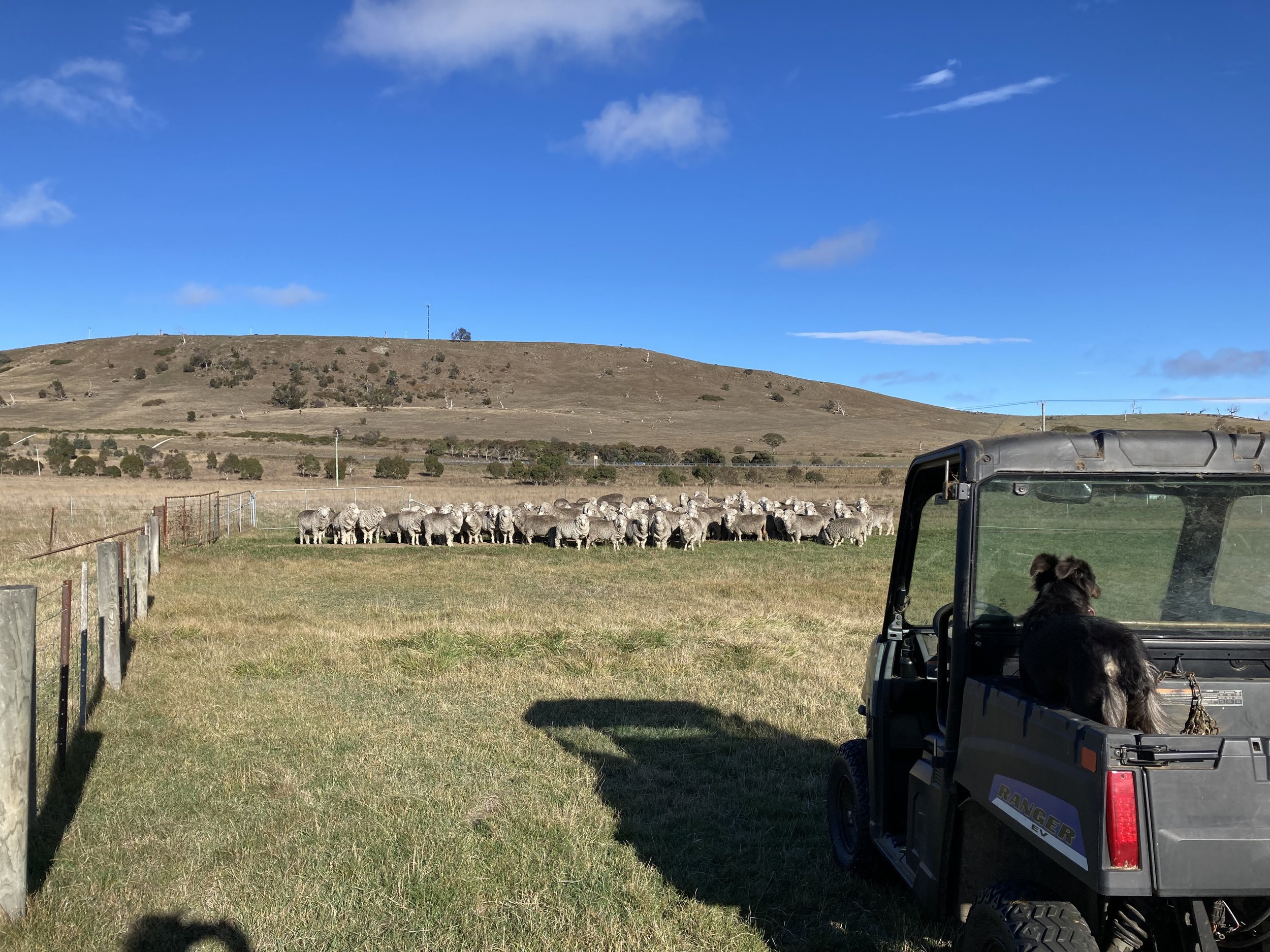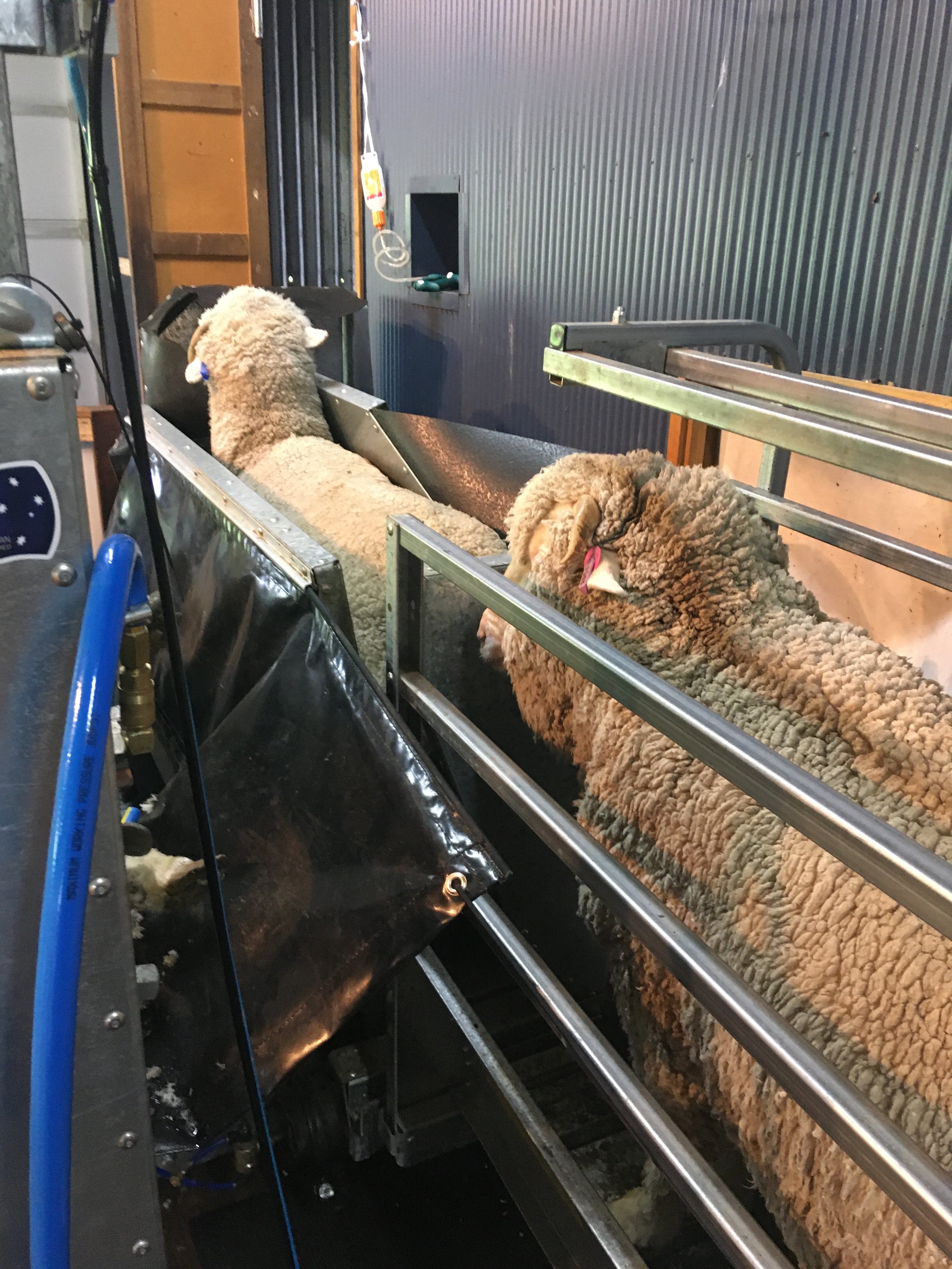Note to self: you need to change your mindset well before shearing next year. Let this be your reminder to practice staying in the present moment almost all the time, rather than just occasionally. If you don’t, you will, at the very least, leave a critical gate open and lose your sheep into the back country when you really, really don’t want them there, and don’t have the time to gather them back into the fold. There was a lot of swearing, none of it particularly inventive, when I did precisely that two days ago, on my fifth straight day, and 7th out of a total of 12 days of shearing.
You know how when you live in a temperate climate, like Tasmania, and then visit a hot, humid place like northern Queensland, and you simply cannot remember just how hot and sticky it really is, and so you don’t take the right clothes? Well, shearing is a bit that way. Because it only happens once a year, I consistently underestimate just how much hard physical and mental work it is.
Fly watching her sheep we take the first contingent into the shed.
So I thought if I wrote a post about it, while I’m still in the middle of it, I just might read the post next year well before shearing and be reminded.
Shearing is the antithesis of my normally pretty cruisy life on the farm. For the other 50 weeks of the year, we rise a bit after the sun, have a leisurely schedule of exercise and mostly light stock work (like just riding around the flock) or farm work (like cleaning out the workshop). Lunch break is long enough to catch an episode of whatever old TV series I’m catching up on from the years when I frowned on TV. Doggie dinners are served before dark, and we hang up the computer after dinner. Mental exercise is analytical and occasionally creative.
Shearing, in contrast, is run to a military schedule with no respect for when daylight arrives or departs. A 5 am wake-up (full dark in May) is required in order to get myself into gear, get the fire started in the wool shed, get the sheep lined out into the race running up to the shearing platform and clean up the last fleece of the day before, abandoned in a futile rush to get back to run the dogs before dark at 5:30 pm. Then back home to run the dogs in the pre-dawn light, hoping no kangaroos cross our path and lure Fly into chasing them from hell to breakfast. Never mind breakfast, no time for that, but there will be a bacon and egg sandwich at morning smoko, on the dot of 9:30.
Then back to the shed by 7:30 sharp to be roustabout, penner-up, presser, cook, and general dogsbody, with half-hour breaks for smoko (9:30 and 3) and an hour for lunch at 12. A fleece hits the table about every 8 minutes, and has to be skirted, the belly trimmed to get rid of the worst of the seeds, thistle and stain, the crutchings swept up and the stained bits sorted from the usable bits, any long toes trimmed, and the next sheep encouraged up the ramp into the shearing machine.
Freddie second in the shearing queue.
Good, sound fleeces go directly into the press, and when there’s 150 kg or so in the press, the bale is closed up, levered out, stencilled and moved to the storage area in the loading dock. If there’s nothing else needing to be done before the next fleece hits the table, the short ‘locks’ of wool that fall to the floor through the slats in the wool table need to be swept up so they don’t get stuck on the bottoms of your shoes. As soon as the next fleece arrives, around you go again.
The fleece just hit the table.
It is a bit ironic that in shifting to a stand-up shearing platform to make shearing easier for the shearer, I made it much more demanding for me. This is because shearing on the platform is much slower than conventional shearing—overall, a really wonderful result, as the whole process is much calmer and more fulfilling than the go-fast-and-break-things pace in a conventional shed. The quandary for me is that I truly don’t need any shed hands—there just isn’t enough work to justify more than one person on the floor. However, 8 solid hours of walking fast in small circles and up and down stairs is seriously hard yakka.
Bales mounting up.
And although it’s my body that complains at the end of the day, by the next morning I’m recovered enough to do it again. The harder thing is to change how my brain works. There’s a huge amount of planning needed to get all the pieces into place, not least the groceries, since I will only have my lunch break free to do anything requiring more than a few minutes, and invariably that involves moving sheep. So if it’s not in my fridge, freezer or cupboard at the beginning of shearing, we won’t be having it.
Planning is something I’m good at, so I mostly get that right. Here’s the really hard part. I have to keep a bunch of things in my head all the time, but never lose focus on the job that’s right in front of me. Mostly that job is repetitive—nothing inherent about it keeps my attention engaged, but if I wool-gather, yucky bits of wool will end up in the fleece bin, or the sheep won’t be kept up to the machine, or worse, will be ‘boxed up’ with other sheep meant to be kept separate.
Sheep need to be in the shed overnight to stay dry and also to ‘empty out’ so they aren’t eliminating while we’re shearing. However, they can’t stay in the shed for more than a day without food and water. So there’s always a group of sheep that are definitely going to be shorn that day, a group that might be shorn that day, a group that has to go out for a sip and sup before coming back in for the next day, and then the odd sheep that needs vet care and has to be shuffled sideways into a paddock where she can be found again easily. The gates in the shed that allow you to do all this open in clever ways to allow or block the flow of sheep. Get it wrong and swearing ensues. Not to mention lost time, which you don’t have because…the next fleece just hit the table.
My analogy is that shearing is like a long hiking trip: hard physical exercise with a completely different mindset from normal life. Lots of steps, lots of lifting, a tendency to go into the zone which can well mean missing a trail junction that will cost you hours, and a huge amount of planning ahead, without which you may have to suffer through many meals without salt. I didn’t have children, but I suspect keeping a family in good repair has many of the same attributes.
In my twenties, hiking in the High Sierra mountains of California. Due to inattention on my part, we were lost for several hours before stumbling onto the right trail. My grin of relief says it all.
And even though every year I vow to get more help, I still end up feeling like it’s good for me to experience what days of hard physical and mental work feel like, particularly for not enough pay. It reminds me how much admiration is due to all of those among us who are in service to others in some way, and walk at least as many miles, lift at least as many kilos and pay at least as much attention to detail every single day as I do for a couple of weeks each year.






